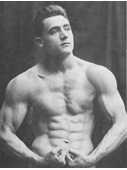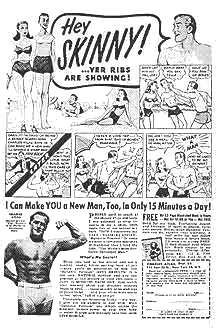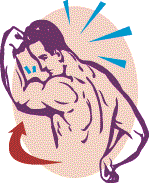
We're an all volunteer website and need your help to keep going. Here are five ways you can contribute: 1 Donate 2 Buy something 3 Submit a story 4 Volunteer 5 Advertise

New in the gift shop, virtualitalia.com logo wear and use items! 
|
PLEASE NOTE: We are experiencing unexpected
technical difficulties caused by our web host. We apologize for
the inconvenience. During your visit you may experience service
and page interruptions - we are in the process of fixing everything and hope to be
fully back on our feet soon.
the hero of the beach
Angelo's unlikely transformation was sparked by two incidents: yet another humiliation by a bully -- this time, a big lug kicked sand in his face on a Coney Island beach and waltzed off with his gal - and a visit to the zoo. Red-faced and girl-less, Angelo found solace admiring and envying the fiercest of all the beasts, the lions, at Brooklyn's Prospect Park Zoo. His epiphany came when he noticed that as the mighty kings of the jungle stretched, their muscles bulged. Those lions, spindly Angelo concluded, were exercising. If they could build muscle that way, so could he-- in fact, so could anybody. Transformation and shifting identity have always been at the core of the immigrant experience. Angelo, using isometric exercises, pumped himself up into the persona of Charles Atlas -- and his advertising alter ego, "Mac," the scourge of beach bullies everywhere -- in an astonishingly short time. But muscles weren't the half of it; dubbing his exercise program "Dynamic-Tension," Atlas built a mail-order empire by promising hollow-chested half-pints, "I'll prove that you can have a body like mine!"
Skinny Angelo tried the same thing and the rest is history: "In less than twelve months by this method of exercising, I doubled my weight, and I became so strong that I beat up the guy who had given me the beating." In 1922, Charles Atlas was named the "World's Most Perfectly Developed Man" in a contest at New York's Madison Square Garden, and in 1929 he formed a partnership with advertising salesman Charles P. Roman to market an exercise regime -- a decision that sealed Atlas' fame and fortune. Roman's advertising campaign -- "The insult that made a man out of Mac" -- re-created Angelo Siciliano's moment of shame on the beach. After a bully kicks sand in his face and struts off with his date, "Mac" sends away for the Charles Atlas course. He returns in triumph, knocks out the bully, reclaims the girl and is declared "The Hero of the Beach" by awe-struck sunbathers. Fondling Mac's biceps, the object of his desire declares, "Oh Mac, you are a REAL man after all!"
Atlas and Roman sold millions of the programs -- which came complete with
diplomas -- and promoted the venture by helping to train celebrity athletes
like Jack Dempsey and Joe DiMaggio. In the 1950s, the American Medical
Association enthusiastically endorsed his methods. Atlas performed public
feats of strength well into his 60s; once, tethered to a rope, he pulled a
145,000-pound railroad car 112 feet through a Long Island rail yard. Atlas
died in 1972, but Charles Atlas Ltd. lives on and continues to sell the
original isometric exercise program, vitamins and supplements, and workout
gear.
The image Atlas created transcended the business he built and permeated the popular culture. That image has been the subject of a bootlegged Bob Dylan song ("I'm Not Charles Atlas") and of countless television comedy sketches. Just last year, Atlas Ltd. was at the center of a federal court case over the limits of parody. In the parody ad, a muscled tough guy returns to the beach and punches out the girl who spurned him. Atlas trademark owner Hogue sued over the parody but the court ruled that Atlas was such a widely known cultural symbol that his persona is essentially public property. Atlas' promise to turn weaklings into warriors also became a centerpiece of the cult-film "The Rocky Horror Picture Show," which was recently turned into a smash Broadway play. At the zenith of his fame, sculptors used Atlas' physique as a model for heroic statues of George Washington in New York's Herald Square, Alexander Hamilton at the Treasury Building in Washington, D.C., the archer in front of the Brooklyn Museum and at least 75 other public monuments. Unlike some of the dubious exercises gurus who pitch diets and exercise schemes on late-night television, Charles Atlas was strictly legit. Although it's doubtful many disciples were able to lift cars or bend steel bars after taking the course -- as Atlas ads implied they might, physical therapists and professional athletic trainers today use the same isometric principles Atlas touted to restore and build muscle in their clients. Atlas' brains and ambition matched his brawn. He understood perfectly why his legend and his promise appealed to so many underdeveloped boys in a culture obsessed with image and power. "Nobody," he said, "picks on a strong man."
|
© 1998-2005 by virtualitalia.com unless otherwise noted
 America welcomed immigrants at the turn of the century because it
needed muscle and brawn to build the nation's roads and dams and cities. Angelo
Siciliano, who stepped off a boat onto Ellis Island in 1903, did not appear
likely to be of much help. In fact, the scrawny 10-year-old would become a
punching bag for bigger, more aggressive boys.
Little did anyone suspect that little Angelo would go on to become an
American Hercules, the rippled leading he-man of endless adventures in
ubiquitous comic book and pulp magazine advertisements for more than half a
century.
America welcomed immigrants at the turn of the century because it
needed muscle and brawn to build the nation's roads and dams and cities. Angelo
Siciliano, who stepped off a boat onto Ellis Island in 1903, did not appear
likely to be of much help. In fact, the scrawny 10-year-old would become a
punching bag for bigger, more aggressive boys.
Little did anyone suspect that little Angelo would go on to become an
American Hercules, the rippled leading he-man of endless adventures in
ubiquitous comic book and pulp magazine advertisements for more than half a
century.
 Atlas recalled his encounter with destiny in countless newspaper
interviews. "Well, sir," he would explain, often holding forth in
leopard-skin tights, "I was standing there in front of a lion's cage, and
the old gentleman was lying down asleep, and all of a sudden he gets up and
gives a stretch. Well, he stretched himself all over -- you know how they
do, first one leg and then another -- and the muscles ran around like rabbits
under a rug. I says to myself, Does this old gentleman have any barbells,
any exercisers? No, sir. Then what's he been doing? And it came to me.
I said to myself, He's been pitting one muscle against another."
Atlas recalled his encounter with destiny in countless newspaper
interviews. "Well, sir," he would explain, often holding forth in
leopard-skin tights, "I was standing there in front of a lion's cage, and
the old gentleman was lying down asleep, and all of a sudden he gets up and
gives a stretch. Well, he stretched himself all over -- you know how they
do, first one leg and then another -- and the muscles ran around like rabbits
under a rug. I says to myself, Does this old gentleman have any barbells,
any exercisers? No, sir. Then what's he been doing? And it came to me.
I said to myself, He's been pitting one muscle against another."
 Jeffrey C. Hogue, who bought the firm from Roman before the adman's
death in 1999, said Atlas' name still resonates in the marketplace. "We've
got 70 years of advertising dollars out there," Hogue says. "The name
Charles Atlas is synonymous with strength, health, perfection -- and probably
above all else, the idea of the little guy standing up to the big guy."
Charles Atlas appeared on the scene at the height of the "physical
culture" craze in the United States. Other strongmen and con men sold
programs promising to transform milquetoasts into men of steel. But Charles
Atlas became even bigger than the ads that made him famous.
Jeffrey C. Hogue, who bought the firm from Roman before the adman's
death in 1999, said Atlas' name still resonates in the marketplace. "We've
got 70 years of advertising dollars out there," Hogue says. "The name
Charles Atlas is synonymous with strength, health, perfection -- and probably
above all else, the idea of the little guy standing up to the big guy."
Charles Atlas appeared on the scene at the height of the "physical
culture" craze in the United States. Other strongmen and con men sold
programs promising to transform milquetoasts into men of steel. But Charles
Atlas became even bigger than the ads that made him famous.
